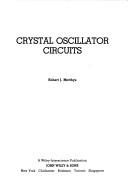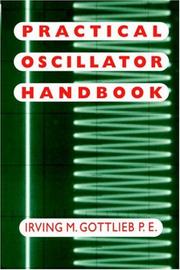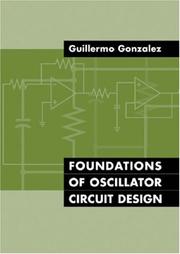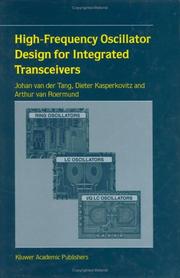| Listing 1 - 10 of 12 | << page >> |
Sort by
|

ISBN: 0471874019 Year: 1983 Publisher: New York Wiley J. & Sons
Abstract | Keywords | Export | Availability | Bookmark
 Loading...
Loading...Choose an application
- Reference Manager
- EndNote
- RefWorks (Direct export to RefWorks)
621.373.1 --- Oscillatoren --- Oscillators, Crystal --- Piezo-electric oscillators --- Quartz oscillators --- Quartz plate oscillators --- Quartz resonators --- Crystallography --- Crystals --- Electron tubes --- Electronics --- Frequency standards --- Oscillators, Electric --- Piezoelectric devices --- Quartz

ISBN: 1281072699 9786611072698 0080539386 0750631023 9780080539386 9780750631020 Year: 1997 Publisher: Oxford ; Boston : Newnes,
Abstract | Keywords | Export | Availability | Bookmark
 Loading...
Loading...Choose an application
- Reference Manager
- EndNote
- RefWorks (Direct export to RefWorks)
Oscillators have traditionally been described in books for specialist needs and as such have suffered from being inaccessible to the practitioner. This book takes a practical approach and provides much-needed insights into the design of oscillators, the servicing of systems heavily dependent upon them and the tailoring of practical oscillators to specific demands. To this end maths and formulae are kept to a minimum and only used where appropriate to an understanding of the theory.Once grasped, the theory of the general oscillator is easily put into practical use in actual osci
Oscillators, Electric --- Electric apparatus and appliances --- Apparatus, Electric --- Appliances, Electric --- Electric appliances --- Electrical engineering --- Electricity --- Instruments, Electric --- Electric oscillators --- Apparatus and appliances --- Physical instruments --- Electric machinery --- Radio
Book
ISBN: 1789858380 1789858372 1838810684 Year: 2019 Publisher: IntechOpen
Abstract | Keywords | Export | Availability | Bookmark
 Loading...
Loading...Choose an application
- Reference Manager
- EndNote
- RefWorks (Direct export to RefWorks)
An oscillator is dedicated to the generation of signals. It is used in computers, telecoms, watchmaking, astronomy, and metrology. It can be a pendulum, an electronic oscillator based on quartz technology, an optoelectronic oscillator, or an atomic clock, depending on its application. Since water clocks of antiquity, mechanical clocks invented during the thirteenth century, and the discovery of piezoelectricity by Jacques and Pierre Curie in 1880, oscillators have made great progress. This book does not attempt to tell the story of oscillators, but rather provides an overview of particular oscillator structures through examples from mathematics to oscillators, and from the millimeter scale to the vibration of a building, focusing on recent developments, as we live in a time when technology and mathematical analysis play a vital role.
Oscillators, Electric --- Mathematical models. --- Electric oscillators --- Electric apparatus and appliances --- Electric machinery --- Radio --- Engineering --- Physical Sciences --- Engineering and Technology --- Electrical and Electronic Engineering --- Mathematical Modeling

ISBN: 1596931639 9781596931633 9781596931626 1596931620 Year: 2007 Publisher: Boston Artech house
Abstract | Keywords | Export | Availability | Bookmark
 Loading...
Loading...Choose an application
- Reference Manager
- EndNote
- RefWorks (Direct export to RefWorks)
Oscillators are an important component in today's RF and microwave systems, and practitioners in the field need to know how to design oscillators for stability and top performance. Offering engineers broader coverage than other oscillator design books on the market, this comprehensive resource considers the complete frequency range, from low-frequency audio oscillators to more complex oscillators found at the RF and microwave frequencies. Packed with over 1,200 equations, the book gives professionals a thorough understanding of the principles and practice of oscillator circuit design and emphasizes the use of time-saving CAD (computer aided design) simulation techniques. From the theory and characteristics of oscillators, to the design of a wide variety of oscillators (including tuned-circuit, crystal, negative-resistance, and relaxation oscillators), this unique book is a one-stop reference practitioners can turn to again and again when working on their challenging projects in this field.
Oscillators, Electric. --- Electronic circuits. --- Electron-tube circuits --- Electric circuits --- Electron tubes --- Electronics --- Electric oscillators --- Electric apparatus and appliances --- Electric machinery --- Radio --- Electronic circuits --- Oscillators, Electric
Book
ISBN: 1281674788 9786611674786 1402085168 140208515X 9048178975 Year: 2008 Publisher: [Dordrecht] : Springer,
Abstract | Keywords | Export | Availability | Bookmark
 Loading...
Loading...Choose an application
- Reference Manager
- EndNote
- RefWorks (Direct export to RefWorks)
The following features of Analysis and Design of Quadrature Oscillators make it different from the existing literature on electronic oscillators: focus on quadrature oscillators with accurate quadrature and low phase-noise, required by modern communication systems; a detailed comparative study of quadrature LC and RC oscillators, including cross-coupled LC quasi-sinusoidal oscillators, cross-coupled RC relaxation oscillators, a quadrature RC oscillator-mixer, and two-integrator oscillators; a thorough investigation of the effect of mismatches on the phase-error and the phase-noise; the conclusion that quadrature RC oscillators can be a practical alternative to LC oscillators when area and cost should be minimized (in cross-coupled RC oscillators both the quadrature-error and phase-noise are reduced, whereas in LC oscillators the coupling increases the phase-noise); use of a structured design approach, in which a technology independent study, with ideal blocks, is performed initially, and then the circuit level design is addressed; inclusion of many experimental results, obtained from different integrated circuit prototypes, in the GHz range.
Oscillators, Electric. --- Oscillators, Electric --- Design. --- Engineering. --- Electronic circuits. --- Circuits and Systems. --- Electron-tube circuits --- Electric circuits --- Electron tubes --- Electronics --- Construction --- Industrial arts --- Technology --- Electric oscillators --- Electric apparatus and appliances --- Electric machinery --- Radio --- Systems engineering. --- Engineering systems --- System engineering --- Engineering --- Industrial engineering --- System analysis --- Design and construction

ISBN: 1280459492 9786610459490 0306487160 1402075642 Year: 2003 Publisher: Boston : Kluwer Academic,
Abstract | Keywords | Export | Availability | Bookmark
 Loading...
Loading...Choose an application
- Reference Manager
- EndNote
- RefWorks (Direct export to RefWorks)
High-Frequency Oscillator Design for Integrated Transceivers covers the analysis and design of all high-frequency oscillators required to realize integrated transceivers for wireless and wired applications. This includes the design of oscillator types as single-phase LC oscillators, I/Q LC oscillators, multi-phase LC oscillators, and ring oscillators in various IC technologies such as bipolar, BiCMOS, CMOS, and SOI (silicon on insulator). Starting from an in depth review of basic oscillator theory, the authors discuss key oscillator specifications, numerous oscillator circuit topologies, and introduce the concepts of design figures of merit (FOMs) and benchmark FOMs, which assist the oscillator designer during the overall design cycle. Taking advantage of behavioral modeling, the elementary properties of LC oscillators and ring oscillators are analyzed first. A detailed analysis of oscillator properties at circuit level follows taking parasitic elements and other practical aspects of integrated oscillator design into account. Special attention is given to advantages and limitations of linear time invariant (LTI) phase noise modeling, leading to the concept of optimum coupling in I/Q LC oscillators and a simulation method for fast and efficient phase noise optimization in oscillators. In addition, all modern linear time variant (LTV) phase noise theories are covered. As not only phase noise is of high importance to the designer, but optimization of other oscillator properties as well, additional subjects such as various tuning methods of LC oscillators are analyzed, too. Design examples of integrated LC and ring oscillators in the frequency range of 100 MHz up to 11 GHz are thoroughly discussed throughout the book. The clear and structured discussion of basic oscillator properties make High-Frequency Oscillator Design for Integrated Transceivers an excellent starting point for the inexperienced oscillator designer. The detailed analysis of many oscillator types and circuit topologies, the discussion of numerous practical design issues together with fast optimization methods, and more than 200 carefully selected literature references on oscillator literature, LC oscillator and ring oscillator designs make this book a very valuable resource for the experienced IC designer as well.
Oscillators, Electric --- Radio --- Design and construction. --- Transmitter-receivers --- Telephone, Wireless --- Wireless (Radio) --- Wireless telephone (Early radio) --- Electric oscillators --- Engineering. --- Electrical engineering. --- Electronic circuits. --- Circuits and Systems. --- Electrical Engineering. --- Communication and traffic --- Telecommunication --- Telegraph, Wireless --- Electric apparatus and appliances --- Electric machinery --- Systems engineering. --- Computer engineering. --- Computers --- Engineering systems --- System engineering --- Engineering --- Industrial engineering --- System analysis --- Design and construction --- Electric engineering --- Electron-tube circuits --- Electric circuits --- Electron tubes --- Electronics
Book
ISBN: 3030256782 3030256774 Year: 2020 Publisher: Cham : Springer International Publishing : Imprint: Springer,
Abstract | Keywords | Export | Availability | Bookmark
 Loading...
Loading...Choose an application
- Reference Manager
- EndNote
- RefWorks (Direct export to RefWorks)
This book demonstrates a novel, efficient and automated scheme to design and evaluate the performance of electronic oscillators, operating at the 100s of Megahertz to 10s of Gigahertz frequencies. The author describes a new oscillator design and performance evaluation scheme that addresses all the issues associated with the traditional S parameter (large, small signal) based oscillator design technique by exploiting the properties of a new breed of RF or microwave transistors, the powerful Discrete Fourier Transform and the SPICE tool's transient analysis. Readers will benefit from an exhaustive set of detailed, step-by-step oscillator (feedback, negative resistance, crystal and differential) design examples, as well as the software tools (C executables) used to create the design examples. Designers will be enabled to eliminate the complexities of the traditional oscillator design/performance evaluation scheme using S (large, small) parameter, resulting in accurate, robust and reliable designs. Describes an efficient, automated oscillator design and performance evaluation scheme that addresses all the challenges associated with the traditional S parameter (large, small signal) based oscillator design; Provides numerous step-by-step design examples, illustrating the details of the new scheme presented; Includes C executables that run on both Linux and Windows, which the reader can use to experiment and design any oscillator (feedback common emitter or base, negative resistance common emitter or base or differential).
Systems engineering. --- Telecommunication. --- Electronics. --- Circuits and Systems. --- Communications Engineering, Networks. --- Electronics and Microelectronics, Instrumentation. --- Electric communication --- Mass communication --- Telecom --- Telecommunication industry --- Telecommunications --- Communication --- Information theory --- Telecommuting --- Engineering systems --- System engineering --- Engineering --- Industrial engineering --- System analysis --- Electrical engineering --- Physical sciences --- Design and construction --- Oscillators, Electric. --- Electric oscillators --- Electric apparatus and appliances --- Electric machinery --- Radio --- Electronic circuits. --- Electrical engineering. --- Microelectronics. --- Microminiature electronic equipment --- Microminiaturization (Electronics) --- Electronics --- Microtechnology --- Semiconductors --- Miniature electronic equipment --- Electric engineering --- Electron-tube circuits --- Electric circuits --- Electron tubes
Book
ISBN: 3030636585 3030636577 Year: 2021 Publisher: Cham, Switzerland : Springer,
Abstract | Keywords | Export | Availability | Bookmark
 Loading...
Loading...Choose an application
- Reference Manager
- EndNote
- RefWorks (Direct export to RefWorks)
This textbook is ideal for senior undergraduate and graduate courses in RF CMOS circuits, RF circuit design, and high-frequency analog circuit design. It is aimed at electronics engineering students, as well as IC design engineers in the field, who wish to gain a deeper understanding of circuit fundamentals and go beyond the widely-used automated design procedures. A design-centric approach is adopted in order to bridge the gap between fundamental analog electronic circuits textbooks and more advanced RF IC design texts. The structure and operation of the building blocks of high-frequency ICs are introduced in a systematic manner, with an emphasis on transistor-level operation, the influence of device characteristics and parasitic effects, and input-output behavior in the time and frequency domains. This second edition has been revised extensively to expand and clarify some of the key topics and to provide a wide range of design examples and problems. New material has been added for basic coverage of core topics, such as wide-band LNAs, noise feedback concept and noise cancellation, inductive-compensated band widening techniques for flat-gain or flat-delay characteristics, and basic communication system concepts that exploit the convergence and co-existence of Analog and Digital building blocks in RF systems. A new chapter (Chapter 5) has been added on Noise and Linearity, addressing key topics in a comprehensive manner. All of the other chapters have also been revised and largely re-written, with the addition of numerous solved design examples and exercise problems. Designed for senior undergraduate and graduate courses in RF CMOS circuits, RF circuit design, and high-frequency analog circuit design; Uses simple circuit models to enable a robust understanding of high-frequency design fundamentals; Employs solved design examples to familiarize the reader with the design flow, starting with knowledge-based and model-based hand-design and progressing to SPICE simulations; Introduces fine-tuning procedures in circuit design with an emphasis on key trade-offs; Demonstrates key criteria and parameters that are used to describe system-level performance. .
Electronic circuits. --- Microwaves. --- Optical engineering. --- Microprocessors. --- Circuits and Systems. --- Microwaves, RF and Optical Engineering. --- Processor Architectures. --- Minicomputers --- Mechanical engineering --- Hertzian waves --- Electric waves --- Electromagnetic waves --- Geomagnetic micropulsations --- Radio waves --- Shortwave radio --- Electron-tube circuits --- Electric circuits --- Electron tubes --- Electronics --- Linear integrated circuits. --- Linear ICs --- Analog integrated circuits --- Analog electronic systems. --- Oscillators, Electric. --- Very high speed integrated circuits. --- VHSIC --- Integrated circuits --- Electric oscillators --- Electric apparatus and appliances --- Electric machinery --- Radio --- Analog electronic devices --- Electronic systems --- Very large scale integration
Book
ISBN: 9781891121869 1891121863 9781891121876 1891121871 9781891121838 1891121839 9781891121845 1891121847 9781891121852 1891121855 Year: 2010 Volume: 4 Publisher: Raleigh Scitech Publishing
Abstract | Keywords | Export | Availability | Bookmark
 Loading...
Loading...Choose an application
- Reference Manager
- EndNote
- RefWorks (Direct export to RefWorks)
This second volume, Designing Dynamic Circuit Response builds upon the first volume Designing Amplifier Circuits by extending coverage to include reactances and their time- and frequency-related behavioral consequences.
Amplifiers (Electronics) --- Electronic circuit design --- Design and construction --- Frequency response (Dynamics) --- Transients (Dynamics) --- Signal generators --- Oscillators, Electric --- Signal processing --- Oscillatoren --- 621.375 --- Amplifiers --- Linear integrated circuits. --- Metal oxide semiconductors, Complementary. --- Electrical & Computer Engineering --- Engineering & Applied Sciences --- Electrical Engineering --- Amplifiers (Electronics) -- Design and construction. --- Amplifiers (Electronics). --- Electronic circuit design. --- Electronics. --- Amplifiers (Electronics) -- History. --- Frequency response (Dynamics). --- Transients (Dynamics). --- 621.375 Amplifiers --- Electronic circuits --- Amps (Electronics) --- Electronic amplifiers --- Radio amplifiers --- Electronics --- Design --- Transient phenomena --- Transient responses --- Dynamics --- Oscillations --- Vibration --- Frequencies of oscillating systems --- Processing, Signal --- Information measurement --- Signal theory (Telecommunication) --- Electronic apparatus and appliances --- Electric oscillators --- Electric apparatus and appliances --- Electric machinery --- Radio --- Testing --- Amplifiers (Electronics) - Design and construction
Book
ISBN: 904819394X 9048193958 Year: 2010 Publisher: New York : Springer,
Abstract | Keywords | Export | Availability | Bookmark
 Loading...
Loading...Choose an application
- Reference Manager
- EndNote
- RefWorks (Direct export to RefWorks)
Electronic oscillators using an electromechanical device as a frequency reference are irreplaceable components of systems-on-chip for time-keeping, carrier frequency generation and digital clock generation. With their excellent frequency stability and very large quality factor Q, quartz crystal resonators have been the dominant solution for more than 70 years. But new possibilities are now offered by micro-electro-mechanical (MEM) resonators, that have a qualitatively identical equivalent electrical circuit. Low-Power Crystal and MEMS Oscillators concentrates on the analysis and design of the most important schemes of integrated oscillator circuits. It explains how these circuits can be optimized by best exploiting the very high Q of the resonator to achieve the minimum power consumption compatible with the requirements on frequency stability and phase noise. The author has 40 years of experience in designing very low-power, high-performance quartz oscillators for watches and other battery operated systems and has accumulated most of the material during this period. Some additional original material related to phase noise has been added. The explanations are mainly supported by analytical developments, whereas computer simulation is limited to numerical examples. The main part is dedicated to the most important Pierce circuit, with a full design procedure illustrated by examples. Symmetrical circuits that became popular for modern telecommunication systems are analyzed in a last chapter.
Electronic circuits. --- Oscillators, Crystal. --- Oscillators, Electric. --- Oscillators, Crystal --- Microelectromechanical systems --- Electrical & Computer Engineering --- Engineering & Applied Sciences --- Electrical Engineering --- Electric oscillators --- Engineering. --- Microwaves. --- Optical engineering. --- Electronics. --- Microelectronics. --- Circuits and Systems. --- Electronics and Microelectronics, Instrumentation. --- Microwaves, RF and Optical Engineering. --- Electric apparatus and appliances --- Electric machinery --- Radio --- Systems engineering. --- Hertzian waves --- Electric waves --- Electromagnetic waves --- Geomagnetic micropulsations --- Radio waves --- Shortwave radio --- Electrical engineering --- Physical sciences --- Engineering systems --- System engineering --- Engineering --- Industrial engineering --- System analysis --- Design and construction --- Mechanical engineering --- Microminiature electronic equipment --- Microminiaturization (Electronics) --- Electronics --- Microtechnology --- Semiconductors --- Miniature electronic equipment --- Electron-tube circuits --- Electric circuits --- Electron tubes
| Listing 1 - 10 of 12 | << page >> |
Sort by
|

 Search
Search Feedback
Feedback About UniCat
About UniCat  Help
Help News
News